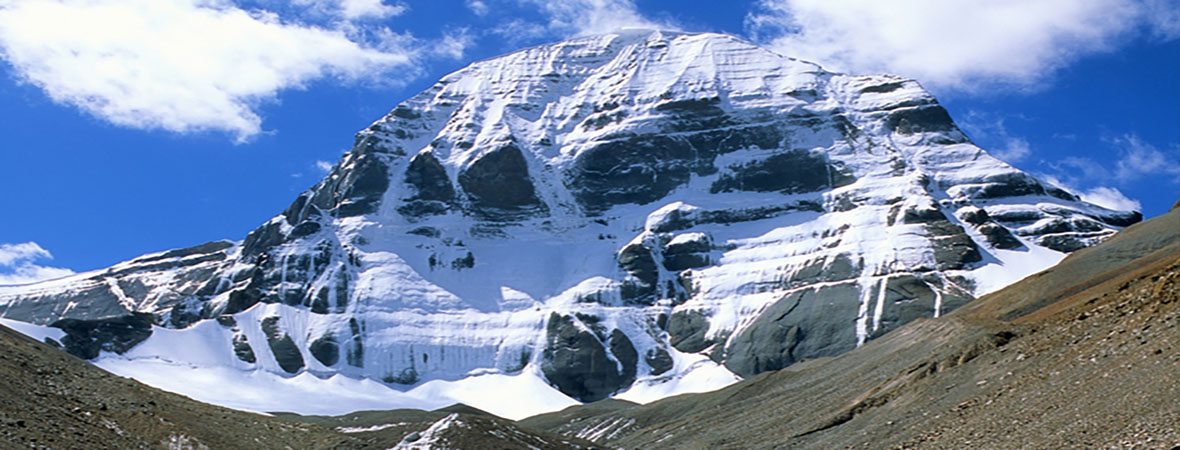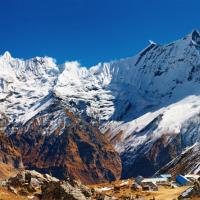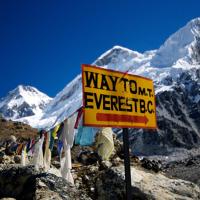KAILASH AND MANSAROVAR TRIP OVERVIEW
17 Days Kailash and Mansarovar Trip
Mount Kailash is considered as the holiest pilgrimage and to be a mythical Mount Meru, the center of the universe. It is located at the heart of six mountain ranges symbolizing a lotus. It is a rock pyramid with a height of 6714 meters situated in China-Tibet Himalayas that can be accessed from Nepal, India and Tibet. The name Kailash literally means Crystal in Sanskrit and holds religious significance from different religions like Hinduism, Buddhism and Jainism.
Every year, thousands of pilgrimage visit the Mount Kailash and practices their ancient tradition going back thousands of years. Pilgrims of numerous religions believe that circumambulating the 52 kilometer route of Mount Kailash on its foot is a very holy ritual that will set one free from all the sins and brings good fortune. Although, the peregrination is made in a clockwise direction by Hindus and Buddhists, however, the followers of the Jain religion circumambulate in an anticlockwise direction.
It is believed that visiting Ngari and yet not completing the “Kora”or the peregrination of Mount Kailash is like visiting a great capital and stopping outside the most famous treasure. Due to China and India political and border disturbances the pilgrimage to the legendary holy four-sided summit was banned from 1984 to 1978. However, things have changed now and people do visit from neighboring countries to pay their homage.
Detail Itinerary
Day 1 - Arrival in Kathmandu
Receive upon arrival at Kathmandu airport and we escort you to the hotel. Overnight will be at hotel in Kathmandu on bed & breakfast basis.
Day 2 - Kathmandu
At AM: We proceed for sightseeing tour of Kathmandu city and Swoyambhunath stupa.
Kathmandu City: The seat of royalty till the last century, Kathmandu Durbar Square is a wondrous cluster of ancient temples, palaces, courtyards and streets. Kumari, the living Goddess, the stone carved statue of ferocious Kal Bhairav, erotic carvings glorifying the art works in the temples, the giant temple of the Goddess Taleju and image of Shiva and Parvati peering outside through the window are just a few of the most noteworthy attractions in the area. One can’t help but admire the exceptionally attractive wood carvings, statues and buildings that is clustered in the area.
Swoyambhunath Stupa: A golden spire crowning a conical wooded hill, Swayambhunath Stupa is the most ancient and enigmatic of all the holy shrines in Katmandu valley. Its lofty white dome and glittering golden spires are visible from many miles and from all sides of the valley. Historical records found on a stone inscription give evidence that the stupa was already an important Buddhist pilgrimage destination by the 5th century AD.
At PM: Proceed for sightseeing tour of Patan city.
Patan City: Nowhere else can be seen such a compression of marvelous monuments within a limited space like in the Patan Durbar Square. Besides the old royal palace, which dominates all others in grace and grandeur, here is the 17th-century Krishna Mandir. Entirely made of stone, this shikhara-style structure with 21 pinnacles is dedicated to Lord Krishna, a savior deity in the Hindu pantheon, and is equally noted for rare stone carvings on its walls, which depict various episodes of the epic wars of Ramayana and Mahabharata. Other landmarks within the Square are Tusha-hity (water spout), Sundari Chowk, Taleju Temple and the Keshav Narayan Chowk. The Hiranyavarna Mahavihar (Golden temple), Rudravarna Mahavihar and the terra-cotta temple of Mahabouddha are other highlights in the vicinity. Overnight will be at hotel in Kathmandu on bed & breakfast basis.
Day 3 - Kathmandu
At AM: Visit to Pashupatinath temple and Boudhanath stupa.
Pashupatinath Temple: One of the most sacred Hindu shrines in the world, Pashupatinath lies on the bank of river Bagmati. The two-storied pagoda houses a sacred Lingum, or the phallic symbol of Lord Shiva. Although the temple dates back to the 4th century, it was brought into its present shape in the early 18th century. The temple is most noted for its gold-plated roofs and silver-coated doors. Sadhus and sages, who follow the lifestyle of Lord Shiva, are seen covered with ashes and loincloths. On the bank of the river Bagmati, there is a continuous cremation going on.
Boudhnath Stupa: Also known as Khasti Chaitya, Boudhanath Stupa is one of the world’s largest stupas. The unique aspect of this great Buddhist monument is that it is set in the octagonal Mandala design. Hundreds of prayer wheels and the 108 images of the Buddha set into the niches around this huge structure make it even more mesmerizing. It is believed to have been constructed in the fifth century and is said to entomb the remains of Kasyap Rishi, a sage respected by both Buddhists and Hindus. Another notable aspect of the area is the presence of about four dozen monasteries around it. It lies some eight km to the east of the city center.
At PM: A free time to spend by yourself. Overnight will be at hotel in Kathmandu on bed & breakfast basis.
Day 4 - Drive to Nyalam (3750m)
We will pick-up from Kathmandu and drive to Zhangmu, the border town of Tibet. After completing the immigration formalities at both Nepal & Tibet side, drive further to Nyalam. Overnight will be at overnight at tented camp or guest house.
Day 5 - Rest day in Nyalam
Today is the rest day in Nyalam in order to get acclimatized and the group will be taken for a short hike in around Nyalam. Overnight will be at guest House or hotel.
Day 6 - Drive to Saga
Heading away from Nyalam, the trail follows a route that brushes past Brahmaputra River. Further ahead, a river valley sprawls over and then traditional picturesque villages come into the picture. This scenic rewarding drive provides plenty of opportunities for photography. Thereon, the trail wends towards northern route. On covering 295km, you reach an elevation of 4600 meters. Shortly after finding a right campsite in Saga, you rest the trip as the night approaches. Overnight will be at the guest house or hotel.
Day 7 - Drive to Paryang (4750m)
Taking another 255km drive from Saga to Paryang, you weave your way through small dusty town of Zhongba amidst enchanting panoramic views. The overnight stay in Paryang at a fabulous campsite with high expectation of the forthcoming Mount Kailash tour and trek, you bask in the most amazing travel experience. Overnight will be at guest House or hotel.
Day 8 - Drive to Lake Manasarovar (4560m)
Prior to Mount Kailash tour and trek you have to transverse along 270 km distance from Paryang to Manasarovar. This route penetrates the very essence of Manasarovar Lake amid extraordinary landscape. As you near this breathtaking sacred lake, historic Chiu Monastery becomes visible on the North West shore of the lake. From this vantage point, you can even glimpse at majestic Mount Kailash. This journey stimulates you spiritually. Overnight will be at guest House or hotel.
Day 9 - Drive to Darchen (4560m)
After some peaceful hours on the shores of the sacred Lake Manasarovar with the snowy massif of Gurla Mandata (Memo Nani) towering at 7694m just across the lake, you drive along the jeep trail to the start of the kora at Tarboche. Tarboche is marked by a tall flagpole adorned with thousands of multi-colored prayer flags and kata scarves strung out in radiating lines from the pole. You stay camp overnight here to begin 53km Kailash Kora. Overnight will be at guest House or hotel.
Day 10 - Darchen (4560m)
Drive to Serlung Monastery and to Asthapath from where one can get the glimpses of the Nandi Parbat and the Holy Mt. Kailash. Rest of the day will be spent for the preparation of Mt. Kailash Parikrama. Overnight will be at guest House or hotel.
Day 11 - Trek to Dira-Puk (4900m)
Early in the morning you meet your team of yaks and Tibetan yak drivers who will escort you around the Kora. Further ahead from Tarboche, you have to trek past verdant meadows and picturesque streams in the Lha Chu Valley. The trail overlooks Turquoise River cascading over a narrow canyon with high steep cliffs. En route, north face of Kailash comes into vision. The trail will approach the 13th century monastery of Dira-Puk. Visiting this monastery can be one kind of an insightful experience gifted in your Mount Kailash tour and trek. Eventually, you will conclude the trek of the day by camping at Dira-Puk. Overnight will be at guest House or hotel.
Day 12 - Trek to Zutul-Puk (4790m)
Lha Chu Valley blurs as you turn towards the Drolma Chu Valley. Looking forward to the amazing Mount Kailash tour and trek, you ascend to Drolma La (5630m), the highest point of the trip. But soon after sighting breathtaking view of the Thukpe Dzingbu Lake, known as the Lake of Compassion at the summit, you realize that this tough and challenging ascent has indeed been very worthwhile and fruitful. Several prayer flags can be seen at the summit. Further on, the trail descends to the flat fields of Zutul-Puk which houses a monastery and several fascinating caves. The caves at this locale are most popular for meditation; Milarepa’s cave being one of them with Milarepa’s footprints and elbow prints believed to be imprinted all over this cave of many stones. Camping at Zutul-Puk for the night can be quite exciting, adventurous and pleasurable. Overnight will be at guest House or hotel.
Day 13 - Drive to Paryang (4750m)
Away from Zutul-Puk, you follow the trail through Bharkha plain leading to Darchen. It is an easy walk along some impressive gorges and around many, many stones and mani walls back to the Bharka Plains and dusty Darchen. The kora is finished – you have erased your sins, endured cold nights and mornings, crossed one of the highest passes in the world, met countless fellow pilgrims, sent prayers of peace out to the world. Shortly after arriving at Darchen you board the waiting vehicle and drive crossing Mayum-la and several rivers to Paryang. The scenery along this section is some of the most beautiful of the entire journey, and a distant storm drifting in back of Tibetans, horses & sheep are a surreal sight. Overnight will be at guest House or hotel.
Day 14 - Drive to Saga (4600m)
You continue driving for another 255km to Saga, passing through the dusty town of Zhongba and a few smaller passes. Overnight will be at guest House or hotel.
Day 15 - Drive to Nyalam (3750m)
Crossing Yarlung Tsangpo (Brahmaputra River) by a ferry, you continue driving 250 km to Nyalam. Soon after leaving Saga the road opens into a wide flat plain and passes through the huge turquoise lake, the Peiku-Tso with spectacular view of Shishapangma (8027m) as the backdrop. Further drive across Lalung La (5200m) through a perfect blend of breathtaking views, alpine meadow trails, picturesque hamlets and an abundance of wildflowers finally brings you to Nyalam at 3750 meters. Overnight will be at guest House or hotel.
Day 16 - Drive to Kathmandu (1400m)
From Nyalam, you drive down to the border town of Zhangmu. From Zhangmu, it’s a short drive to the Friendship Bridge which spans the Bhote Kosi River and marks the Chinese – Nepalese border where you part with your Tibetan guide and driver and walk to Nepalese Immigration Control in Kodari where you will be met by your Nepalese staff. After completing the re-entry formalities you continue the drive to Kathmandu which, depending on road and weather conditions, should take about 5-6 hours. Overnight will be at guest House or hotel.
Day 17 - Departure
Free till departure and later, transfer to the International airport to connect the flight to onward destination.











